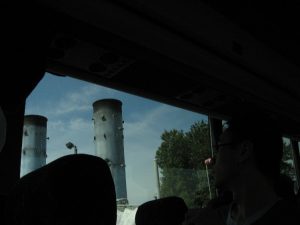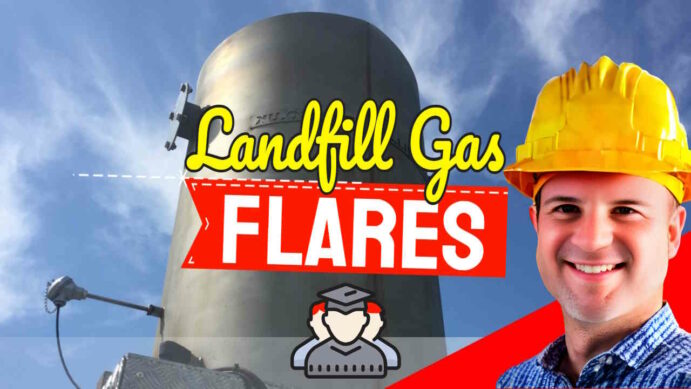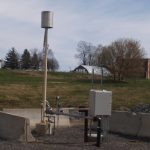About three-fourths of currently operational projects in the United States generate electricity from LFG. Electricity for onsite use or sale to the grid can be generated using a variety of technologies, including reciprocating internal combustion engines, turbines, microturbines, and fuel cells. The reciprocating engine is the most commonly used conversion technology for LFG electricity applications because of its relatively low cost, high efficiency and size ranges that complement the gas output of many landfills. Gas turbines are typically used in larger LFG energy projects while microturbines are generally used for smaller LFG volumes and in niche applications. via www.epa.gov
Candlestick Flares versus Enclosed Flares
Flares can be either open (known as Candlestick Flares) or enclosed flares.
Enclosed Flares

Enclosed flares are typically more expensive, but they provide high combustion temperatures and specific residence times as well as limit noise and light pollution. Some US states require the use of enclosed flares over open flares. Higher combustion temperatures and residence times destroy unwanted constituents such as unburnt hydrocarbons. General accepted values are an exhaust gas temperature of 1000°C with a retention time of 0,3 seconds, which is said to result in greater than 98% destruction efficiency.
Landfill gas must be treated to remove impurities, condensate, and particulates. The treatment system depends on the end use. Minimal treatment is needed for the direct use of gas in boilers, furnaces, or kilns. Using the gas in electricity generation typically requires more in-depth treatment. via en.wikipedia.org
Candlestick Flares
A candlestick flare is a simple flare that is used primarily for combusting excess landfill or other biogas generated by municipal landfill cells or other bio-Methane producers such as bio-digestors. Candlestick flares burn the concentrated fume, which is typically 40%-55% Methane, by discharging the gases through a discharge pipe and through a windshield.
As the gases are discharged, they are exposed to a pilot that will initially ignite the gases. Sustained combustion is typical without a pilot; however, the pilot is available to actuate as needed. Candlestick Flares are typically monitored by a thermocouple and/or UV Flare scanner for Flame activity. A candlestick Flare will combust >98% of constituents when operated properly. via sites.google.com
We recommend our ebook for all readers:
What You’ll Get in This 26-Page PDF
When you download Landfill Gas Management & Flare System Design, you’ll get a powerful, expert-written guide packed with:
✅ Clear explanations of landfill gas behavior – Understand methane generation, gas composition, and why effective management matters more than ever under global climate pledges.
✅ Flare system selection criteria – Learn the differences between open and enclosed flares, low-calorie flare technology, and how to match systems to site-specific conditions.
✅ Design, sizing, and installation best practices – Includes guidance on capacity planning, site prep, equipment requirements, and modular approaches for evolving landfill needs.
✅ Compliance made simple – Navigate EPA, ATEX, DSEAR, and Clean Air Act requirements with confidence.
✅ Maintenance & troubleshooting tips – Stay ahead of breakdowns with proven maintenance schedules and common issue fixes.
✅ Real-world insights – Case studies, lessons learned from failures, and innovative technologies shaping the future of landfill gas control.
Perfect for landfill operators, engineers, consultants, and regulators — this compact guide delivers expert insight you can use right away to improve performance, cut emissions, and stay compliant.
UK Landfill Gas Emissions Control
The Stringent EA Controls, Which Limit UK Landfill Gas Emissions to Minimise the Emission of Carbon Dioxide thought to be a Significant Cause of Climate Change The UK waste management industry is required to control landfill gas emissions to a high standard. The Environment Agency (EA) is responsible for regulating landfills and ensuring that all […]
Landfill Gas Flares – Selection Installation And Maintenance
Landfill gas flares are now destined to be installed in a lot more landfills globally after COP26. This article is intended to help the anticipated influx of industry newcomers with their Landfill Gas Flare selection, installation, and maintenance. One of the international pledges made during the UN International Climate Change Conference 2021 otherwise known as […]
Landfill Gas Flare Monitoring
Landfill Gas Flare Stack Monitoring Limitations Stack monitoring, or more correctly “landfill gas flare monitoring“, can only be carried out on enclosed flares. Enclosed flares are the only landfill gas flare type which can demonstrably provide a known minimum residence time and therefore are the only landfill gas flare type which is now accepted for […]









Нey ѵeгy interesting blog! Does this help to keep the odour under control?